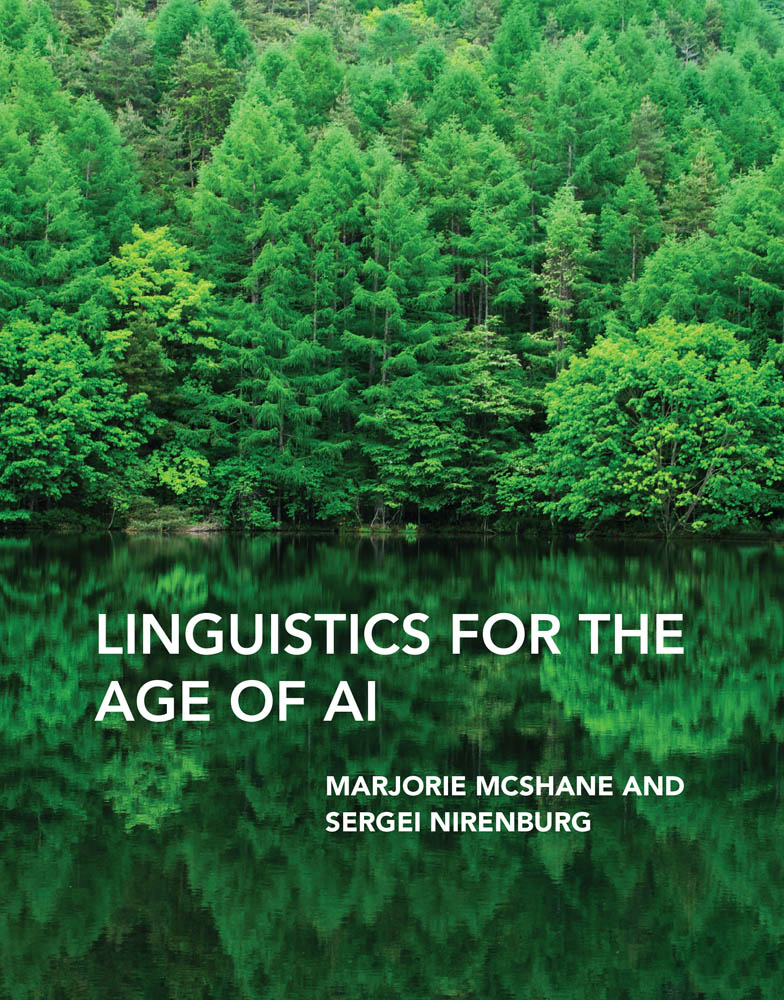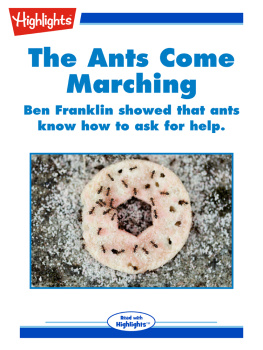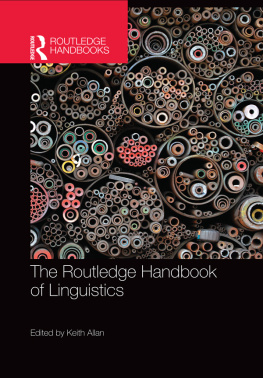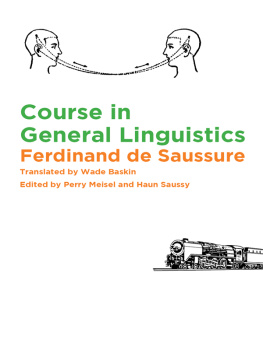Marjorie Mcshane - Linguistics for the Age of AI
Here you can read online Marjorie Mcshane - Linguistics for the Age of AI full text of the book (entire story) in english for free. Download pdf and epub, get meaning, cover and reviews about this ebook. publisher: MIT Press, genre: Home and family. Description of the work, (preface) as well as reviews are available. Best literature library LitArk.com created for fans of good reading and offers a wide selection of genres:
Romance novel
Science fiction
Adventure
Detective
Science
History
Home and family
Prose
Art
Politics
Computer
Non-fiction
Religion
Business
Children
Humor
Choose a favorite category and find really read worthwhile books. Enjoy immersion in the world of imagination, feel the emotions of the characters or learn something new for yourself, make an fascinating discovery.

- Book:Linguistics for the Age of AI
- Author:
- Publisher:MIT Press
- Genre:
- Rating:3 / 5
- Favourites:Add to favourites
- Your mark:
- 60
- 1
- 2
- 3
- 4
- 5
Linguistics for the Age of AI: summary, description and annotation
We offer to read an annotation, description, summary or preface (depends on what the author of the book "Linguistics for the Age of AI" wrote himself). If you haven't found the necessary information about the book — write in the comments, we will try to find it.
Linguistics for the Age of AI — read online for free the complete book (whole text) full work
Below is the text of the book, divided by pages. System saving the place of the last page read, allows you to conveniently read the book "Linguistics for the Age of AI" online for free, without having to search again every time where you left off. Put a bookmark, and you can go to the page where you finished reading at any time.
Font size:
Interval:
Bookmark:

Linguistics for the Age of AI
Marjorie McShane and Sergei Nirenburg
The MIT Press
Cambridge, Massachusetts
London, England
2021 Marjorie McShane and Sergei Nirenburg
This work is subject to a Creative Commons CC-BY-NC-ND license.
Subject to such license, all rights are reserved.

The open access edition of this book was made possible by generous funding from Arcadiaa charitable fund of Lisbet Rausing and Peter Baldwin.

All rights reserved. No part of this book may be reproduced in any form by any electronic or mechanical means (including photocopying, recording, or information storage and retrieval) without permission in writing from the publisher.
Library of Congress Cataloging-in-Publication Data
Names: McShane, Marjorie Joan, 1967- author. | Nirenburg, Sergei, author.
Title: Linguistics for the age of AI / Marjorie McShane and Sergei Nirenburg.
Description: Cambridge, Massachusetts : The MIT Press, [2021] | Includes bibliographical references and index.
Identifiers: LCCN 2020019867 | ISBN 9780262045582 (hardcover)
Subjects: LCSH: Computaitonal linguistics. | Natural language processing (Computer science)
Classification: LCC P98 .M325 2020 | DDC 401/.430285635--dc23
LC record available at https://lccn.loc.gov/2020019867
d_r0
High-level sketch of the OntoAgent architecture.
Horizontal and vertical incrementality.
Stages of vertical context available during NLU by LEIAs.
The control flow of decision-making during semantic analysis.
Decision points during vertical-incremental processing.
The constituency parse for A fox caught a rabbit.
The dependency parse for A fox caught a rabbit.
A visual representation of syn-mapping. For the input He ate a sandwich, eat-v1 is a good match because all syntactic expectations are satisfied by elements of input. Eat-v2 is not a good match because the required words away and at are not attested in the input.
The processing flow involving syn-mapping. If the initial parse generates at least one perfect syn-map, then the agent proceeds along the normal course of analysis (stages 36: Basic Semantic Analysis, Basic Coreference Resolution, Extended Semantic Analysis, and Situational Reasoning). If it does not, then two recovery strategies are attempted, followed by reparsing. If the new parse is perfect, then the agent proceeds normally (stages 36). By contrast, if the new parse is also imperfect, the agent decides whether to optimize the available syn-maps and proceed normally (stages 36) or skip stages 35 and jump directly to stage 6, Situational Reasoning, where computing semantics with minimal syntax will be attempted.
A subset of paired, syntactically identical senses.
A more detailed view of the OntoAgent architecture than the one presented in .
The Maryland Virtual Patient (MVP) architecture.
This is a subset of the binding sets that use eat-v1 to analyze the input Cakeno, chocolate cakeId eat every day. The ellipses in the last row indicate that many more binding sets are actually generated, including even a set that leaves everything unbound, since this computational approach involves generating every possibility and then discarding all but the highest-scoring ones.
Types of modality used in Ontological Semantics
Examples of syntactic components of tag-question constructions
Comparison of best-case analyses of NNs across paradigms
.
VP ellipsis constructions
Referential and nonreferential uses of the same types of categories
Ellipsis-resolved meaning representation for John washed his car yesterday but Jane didnt
Canonical and variable-inclusive forms of idioms recorded as different lexical senses
Classes of comparative examples and when they are treated during NLU
Sample GERD levels and associated properties
Computing, rather than asserting, why patients have different end stages of GERD. Column 2 indicates each patients MODIFIED-TOTAL-TIME-IN-ACID- REFLUX per day. The cells in the remaining columns indicate the total time in acid reflux needed for GERD to advance in that stage. Cells with gray shading indicate that the disease will not advance to this stage unless the patients MODIFIED-TOTAL- TIME-IN-ACID-REFLUX changeswhich could occur, for example, if the patient took certain types of medications, changed its lifestyle habits, or had certain kinds of surgery.
Modeling complete and partial responses to medications. The reduction in MODIFIED-TOTAL- TIME-IN-ACID-REFLUX is listed first, followed by the resulting MODIFIED-TOTAL-TIME-IN-ACID- REFLUX in brackets.
Learning lexicon and ontology through language interaction
Patient-authoring choices for the disease achalasia
Examples of ontological knowledge about tests relevant for achalasia
Examples of knowledge that supports clinical decision-making about achalasia, which is used by the virtual tutor in the MVP system
MVP. Knowledge about the test results expected at different stages of the disease achalasia. Used by the tutoring agent in MVP. The test results in italics are required to definitively diagnose the disease.
Inventory of under-the-hood panes that are dynamically populated during MVP simulation runs
Examples of properties, associated with their respective concepts, whose values can potentially be automatically learned from the literature
Fast-lane elicitation strategy for recording information about physiology and symptoms
Sample precondition of good practice. Domain experts supply the descriptive fillers and knowledge engineers convert it into a formal representation.
Functionalities of a bias-detection advisor in clinical medicine
Four clinical properties of the esophageal disease achalasia, with values written in plain English for readability
Knowledge about expected test results during progression of achalasia
Example of halo-property nests
Examples of constructions that can lead to biased thinking
Learning while assembling the right back leg
Our warmest thanks to
- Stephen Beale, our close collaborator and friend, for his unrivaled expertise in turning ideas into systems;
- Bruce Jarrell and George Fantry, for shaping the vision behind the Maryland Virtual Patient system and showing that domain experts can be remarkable collaborators on intelligent systems;
- Jesse English, Benjamin Johnson, Irene Nirenburg, and Petr Babkin, for their tireless work on translating models into application systems;
- Lynn Carlson, for her meticulous reading of the manuscript and insightful suggestions for its improvement;
- Igor Boguslavsky, for encouraging us to hone our thinking about the theory-system-model distinction that became central to the framing of this work;
- The Office of Naval Research for their generous support over many years;
Font size:
Interval:
Bookmark:
Similar books «Linguistics for the Age of AI»
Look at similar books to Linguistics for the Age of AI. We have selected literature similar in name and meaning in the hope of providing readers with more options to find new, interesting, not yet read works.
Discussion, reviews of the book Linguistics for the Age of AI and just readers' own opinions. Leave your comments, write what you think about the work, its meaning or the main characters. Specify what exactly you liked and what you didn't like, and why you think so.









